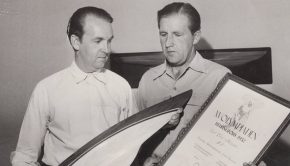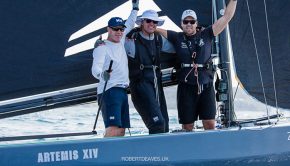Dedicated sailors and historic events
Published on July 23rd, 2019
The International 5.5 Metre class was created to yield a racing keel boat giving a sailing experience similar to that of the International 6 Metre Class, but at a lower cost. Used as an Olympic event for five Games from 1952 through 1968, the Class continues today due to its dedicated sailors and historic events.
A century ago, the Nyländska Jaktklubben – the largest and oldest registered yacht club in Finland – created a rather small and ornate prize for a race between yachts in Scandinavia. That first year, 1949, it was a single race between teams from Sweden and Finland. Sweden won.
Later it was handed over to the Scandinavian Yacht Racing Union (SYRU) and an international competition was sailed in 6 Metres. Since 1953, as the only metre rule keelboat then left in the Olympics, the now highly prestigious Scandinavian Gold Cup has been sailed in 5.5 Metres.
This week, the 100th Anniversary Scandinavian Gold Cup, the 92nd sailing of the Cup, will be sailed back where it all began, in Helsinki. Nine 5.5 Metres will challenge for the honour of winning for their country and their club.
“It’s a nice anniversary of a very prestigious cup, for sure for all Scandinavian countries, where winning this cup is more prestigious and of a higher value than winning the World Championship title,” shared two-time winner, Jurg Menzi (SUI). “It is a ‘sea battle’ with a very special format: fleet racing that ends in match racing. Only first places counts…there is no second.”
The format for the Gold Cup is unlike any other. After three races, only those who have won a race stay in. The winner is the first to three wins. So the event can be over in three races or it can last to the full seven races. At the most, three boats can move to the finals stage.
The fleet is the most competitive for some time. Mark Holowesko, helmsman of last year’s World Champion boat, New Moon, from The Bahamas, said, “We are thrilled to be competing for the Gold Cup. Considering the anniversary, sailing for the Cup is perhaps more exciting than the World Championships and it is an honour to be doing so in Finland where the trophy originated.”
Many regard the Scandinavian Gold Cup as a crucial part of the class’s history, an event that held the interest in the class, and held it together, in the post Olympic years. The defending helmsman is Kristian Nergaard, from Artemis XIV, of Norway, who has been in the class for 20 years, and won the cup seven times as helmsman.
He sees some positive growth in the class in recent years, “I have seen ups and downs on participation, boats being build and the type of sailors who come and go. But at this point I see some positive signals with 2-3 new boats being built and that boats built back to 2003 still being competitive in the modern fleet. Also there is good enthusiasm in the evolution and classics fleets.”
“The Gold Cup has a great history and there is nothing like the cup itself. Also it has been important for the 5.5 Meter class for years.”
The Gold Cup line up:
• Otto (SUI 209, Bent Christian Wilhelmsen, Lasse Berthelsen, Luka Strahovnik
• Caracole (SUI 214, Bernard Haissly, Nicolas Berthoud, Daniel Stampfli)
• 5Billy5 (ITA 79, Henrik Lundberg, Mathias Dahlman, Timo Telkola)
• Marie-Françoise XIX (SUI 228, Jürg Menzi, Cyrus Golchan, Bo Selko)
• Artemis XIV (NOR 57, Kristian Nergaard, Johan Barne, Trond Solli-Sæther)
• New Moon (BAH 21, Mark Holowesko, Christoph Burger, Peter Vlasov)
• Beta Crucis (AUS 63, Martin Cross, Bob Stoddard, Martin Bunch)
• Girls On Film (GBR 40, Peter Morton, Ben Cornish, Sam Haines)
• Ali Baba (GER 84, Wolf-Eberhard Richter, Karsten Melcher, Jörg Sonntag)
Racing begins Wednesday July 24 and continues through to Saturday July 27, but it could be over sooner if one boat is dominant.
Straight after the Scandinavian Gold Cup is the World Championship. This year the class is celebrating 70 years and the worlds has attached 25 entries from nine nations. There is a strong Classic and Evolution fleet. Classics are generally boats built in the Olympic era, while Evolutions are those built between that period and the modern boats built today.
“For this year’s Gold Cup and Worlds I see that there are many good sailors out there to beat,” notes Nergaard. “Looking at past results, it is a typical thing that if you win the Gold Cup, you will not win the Worlds, or vice versa. Winning any of the two regattas would be challenging but I hope our team is well prepared to do well.”
Holowesko admits defending the World Championship will be difficult. “We always approach the racing well prepared and organized to give it our best effort and this year will be the same. The fleet continues to improve in depth, so we always try to improve as well and we look forward to competing next week.”
Racing for the 2019 5.5 Metre World Championship begins on July 29 with a 9 race series ending on August 2.
Details: http://www.njk.fi/the-scandinavian-gold-cup-100th-anniversary-regatta/
Source: Robert Deaves








 We’ll keep your information safe.
We’ll keep your information safe.